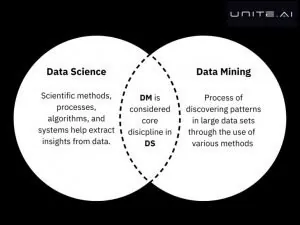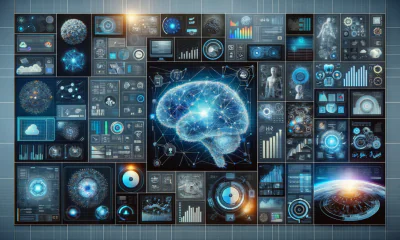Artificial Intelligence
Data Science vs Data Mining: Key Differences

We live in a data-driven world, so there are many concepts involving data that arise. Two such concepts are data science and data mining, both of which are crucial for the success of today’s AI-driven organizations.
It’s important to understand the key differences between the two, so let’s start by formally defining each:
- Data Science: An interdisciplinary field, data science relies on scientific methods, processes, algorithms, and systems to extract or extrapolate knowledge and insights from structured and unstructured data. Knowledge from data is then applied across a wide range of domains.
- Data Mining: The process of discovering patterns in large data sets through the use of methods involving a combination of machine learning, statistics, and database systems. An interdisciplinary subfield of computer science and statistics, the overall goal of data mining is to extract information from a data set and transform it to be used further.
What is Data Science?
In the field of data science, experts extract meaning from data through a series of methods, algorithms, systems, and tools. These provide data scientists with the necessary arsenal to extract insight from both structured data, which is highly specific and stored in a predefined format, and unstructured data, which involves various types of data stored in their native formats.
Data science is incredibly helpful for extracting valuable insights about business patterns, helping organizations perform better with deep insights into processes and consumers. Without data science, big data is nothing. While big data is responsible for hundreds of billions of dollars of spending across industries, bad data is estimated to be costing the U.S. around $3.1 trillion a year, which is why data science is so crucial. Through the use of data processing and analysis, this loss can be turned into value.
The rise of data science is parallel with the rise of smartphones and the digitization of our daily lives. There is an incredible amount of data floating around in our world, and more is produced each day. At the same time, computer power has drastically increased while decreasing in relative cost, resulting in the wide availability of cheap computing power. Data science combines digitization and cheap computing power to extract more insight than ever before.
What is Data Mining?
When it comes to data mining, professionals sort through large data sets to identify patterns and relationships that help solve business problems through data analysis. The interdisciplinary field involves several data mining techniques and tools that are used by businesses to predict future trends and make better business decisions.
Data mining is actually considered a core discipline in data science, and it is just one step in the knowledge discovery in databases (KDD) process, which is a data science methodology for gathering, processing, and analyzing data.
Data mining is key to successful analysis initiatives, generating information that can be used in business intelligence (BI) and advanced analytics. When performed effectively, it improves business strategies and operations including marketing, advertising, sales, customer support, manufacturing, supply chain management, HR, finance, and more.
The data mining process is usually split into four stages:
- Data Gathering: Data scientists identify and assemble relevant data for analytics applications. The data can either come from a data warehouse, a data lake, or some other repository containing both unstructured and structured data.
- Data Preparation: Data is prepared to be mined. Experts begin with data exploration, profiling and preprocessing before cleaning data to correct errors and improve its quality.
- Data Mining: After the data has been prepared, a data scientist settles on a data mining technique and implements one or more algorithms to carry it out.
- Data Analysis: The results of the data mining help develop analytical models that can improve decision-making and business actions. Findings are also shared with business executives and users through data visualization or some other technique.
Key Differences Between Data Science and Data Mining
Here is a list of points that describe key differences between data science and data mining:
- The field of data science is broad and includes the capturing of data, analysis, and the extraction of insights. Data mining involves techniques that help find valuable information in a dataset before using it to identify hidden patterns.
- Data science is a multidisciplinary field consisting of statistics, social sciences, data visualizations, natural language processing, and data mining. Data mining is a subset of data science.
- Data science relies on every type of data, no matter if it’s structured, semi-structured, or unstructured. Data mining usually only involves structured data.
- Data science has been established since the 1960s, while data mining only became known in the 1990s.
- The field of data science focuses on the science of data, while data mining is more concerned with the actual process.
This is by no means an exhaustive list of the differences between the two concepts, but it covers some of the main ones.

Role and Skills of a Data Scientist
A data scientist must first understand the goals of an organization, and they do this by working closely with stakeholders and executives. They then examine how data can help achieve those goals and propel the business forward.
Data scientists are required to be flexible and open to new ideas, and they should be able to develop and propose innovative solutions across fields. Usually working in collaborative teams, data scientists must also possess an awareness of business decisions within different departments. This enables them to focus efforts on data projects that will play a critical role in business decision-making.
The role of a data scientist will likely continue to get more integrated into a business as projects move forward, so they will develop a strong understanding of customer behavior and how data can be effectively used to improve an entire business from top to bottom.
*If you are interested in developing data science skills, make sure to check out our “Top 7 Data Science Certifications.”
The Data Mining Process
Data scientists or data analysts are responsible for the data mining process, which includes various techniques that are used to mine data for different data science applications. Professionals in this field usually follow a specific flow of tasks along the entire process, and without a structure, analysts might encounter issues that could have easily been prevented in the beginning.
Experts will usually begin by understanding the business long before any data is touched. This will include the goals of the business and what it's trying to achieve by mining data. A data analyst will then understand the data, how it will be stored, and what the final outcome might look like.
Moving forward, they will then begin to gather, upload, extract, or calculate data. It is then cleaned and standardized. Once the data is clean, data scientists can use different techniques to search for relationships, trends, or patterns before assessing the findings of the data model. The data mining process is then concluded with management implementing the changes and monitoring them.
It’s important to note that this is a general flow of tasks. Different data mining processing models will require different steps.














